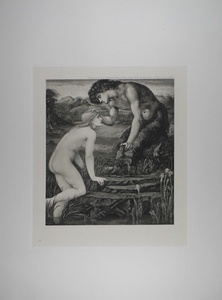| Method | Photogravure |
| Artist | after Sir Edward Coley Burne-Jones |
| Published | Published by the Berlin Photographic Company Berlin. _ London W.133 New Bond Street. _ New York 14 East 23rd Street. [c.1900] |
| Dimensions | Image 234 x 205 mm, Plate 296 x 253 mm, Sheet 667 x 507 mm |
| Notes |
Printed on India laid paper. Plate 16, taken from Burne-Jones' 1898-9 watercolour of the same title, from 'The Work of Edward Burne-Jones, Ninety-One Photogravures Directly Reproduced from the Original Paintings'. Only two-hundred copies of the 'The Work of Edward Burne-Jones...' were produced, each of which was signed by Philip Burne-Jones, the eldest son of Edward. Burne-Jones' subject for 'Cupid and Psyche' is taken from the tale of Cupid and Psyche, featured in Apuleius' 'Metamorphoses'. The tale states that Venus, in a state of jealousy over Psyche's beauty, sends Cupid to destroy Psyche. Pricking himself with his own arrow, Cupid instead falls in love with Psyche, and sends Zephyr, the West Wind, to transport Psyche to Cupid's home. Cupid regularly visits Psyche here, although he never allows her to see him, and Psyche soon falls pregnant. Desperate to uncover her husband's true identity, with concerns that he may be a monster, one night after Cupid falls asleep, Psyche carries a lamp and dagger towards Cupid. Startled by his beauty, Psyche catches herself on one of Cupid's arrows. Struck with sudden passion, Psyche accidentally spills hot oil from the lamp, causing Cupid to wake, and flee. Psyche wanders to find Cupid, facing many trials set by the jealous Venus. Eventually, the two are reunited, and Psyche is immortalised. In 'Pan and Psyche', Burne-Jones depicts Psyche's encounter with Pan, the wilderness god. Following Cupid's departure, Psyche finds herself on the bank of a river. Here, Pan discovers her, and recognises her passion and longing. Burne-Jones presents Psyche emerging from the river, with Pan empathetically placing his hand upon her head. The watercolour from which this photogravure was taken was the second full-length version of the painting executed by Burne-Jones, and is now held in a Private Collection. Sir Edward Coley Burne-Jones, 1st Bt (1833-1898) was a painter and designer closely associated with the later phase of the Pre-Raphaelite movement. Burne-Jones met William Morris as an undergraduate of Exeter College, Oxford, whilst studying for a degree in theology. The pair went on to work very closely together on numerous decorative arts projects including stained glass windows, tapestries, and illustrations. Originally intending to become a church minister, Burne-Jones never finished his degree, choosing instead to pursue an artistic career under the influence of Dante Gabriel Rossetti. Rossetti heavily inspired his early work, but by the 1860's his idiosyncratic style was beginning to develop. His mature work, however different in total effect, is rich in conscious echoes of Botticelli, Mantegna and other Italian masters of the Quattrocento. Thusly, Burne Jones' later paintings of classical and medieval subjects are some of the most iconic of the Pre-Raphaelite movement. He was at the height of his popularity during the 1880's, though his reputation began to decline with the onset of the Impressionists. He was created a baronet in 1894, when he formally hyphenated his name. The Berlin Photographic Company, (1880 - 1920; fl) or the Berlin Photographische Gesellschaft, was a German print publishers who specialised in photogravures after Old Masters and contemporary painters. High quality photographs were taken of the original works. The negatives were then exposed onto a gelatin covered copper plate, etched with acid, and printed in a similar fashion to an engraving. The main series of the Berlin Photographic Company's publications is kept together at Blythe House, West Kensington. Condition: Some foxing and discolouration to margins, water stains to upper right and lower left corners of sheet, not affecting image. |
| Framing | unmounted |
| Price | £450.00 |
| Stock ID | 41517 |

